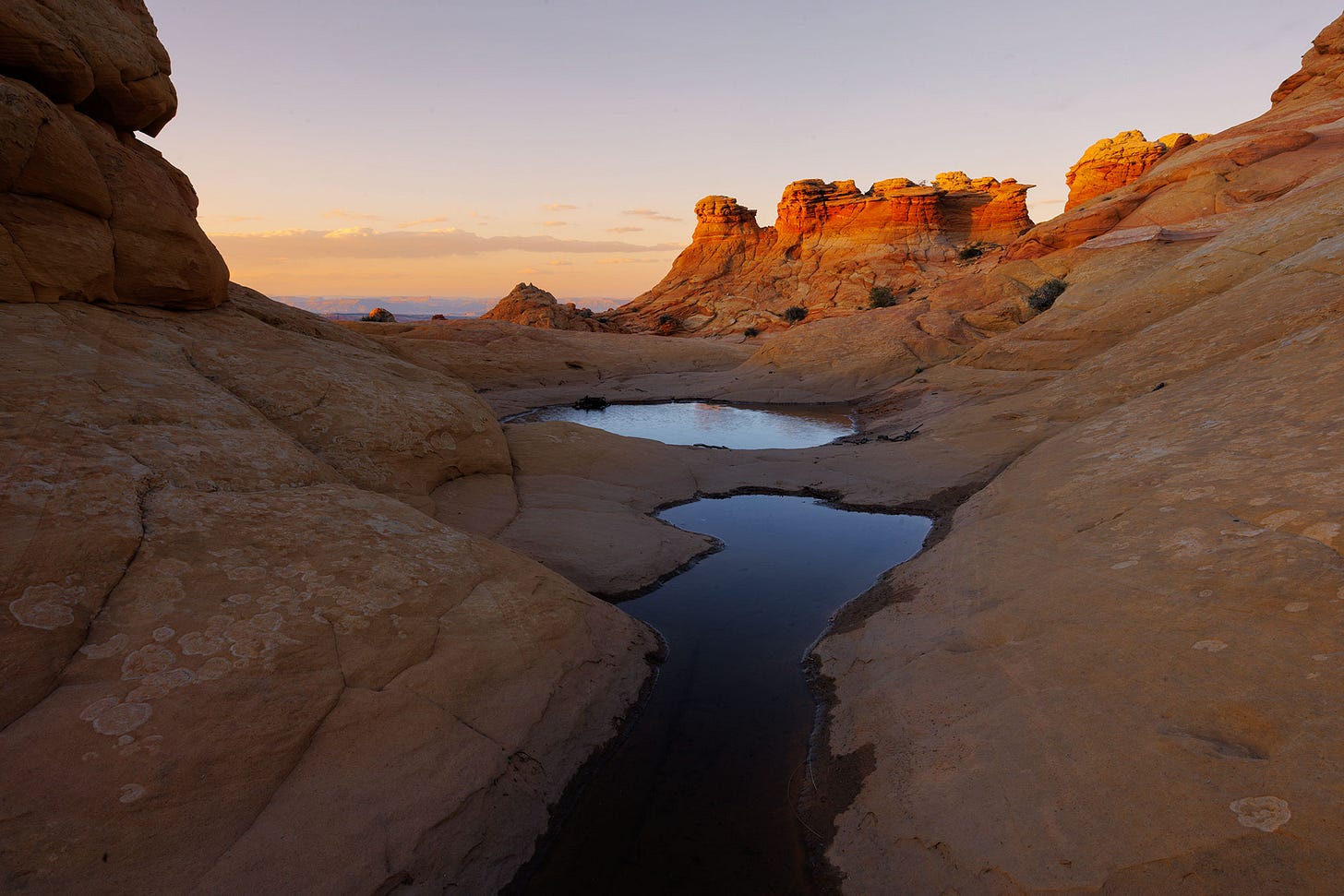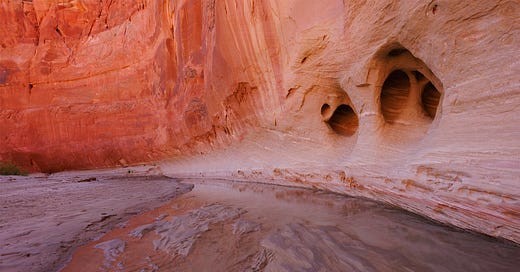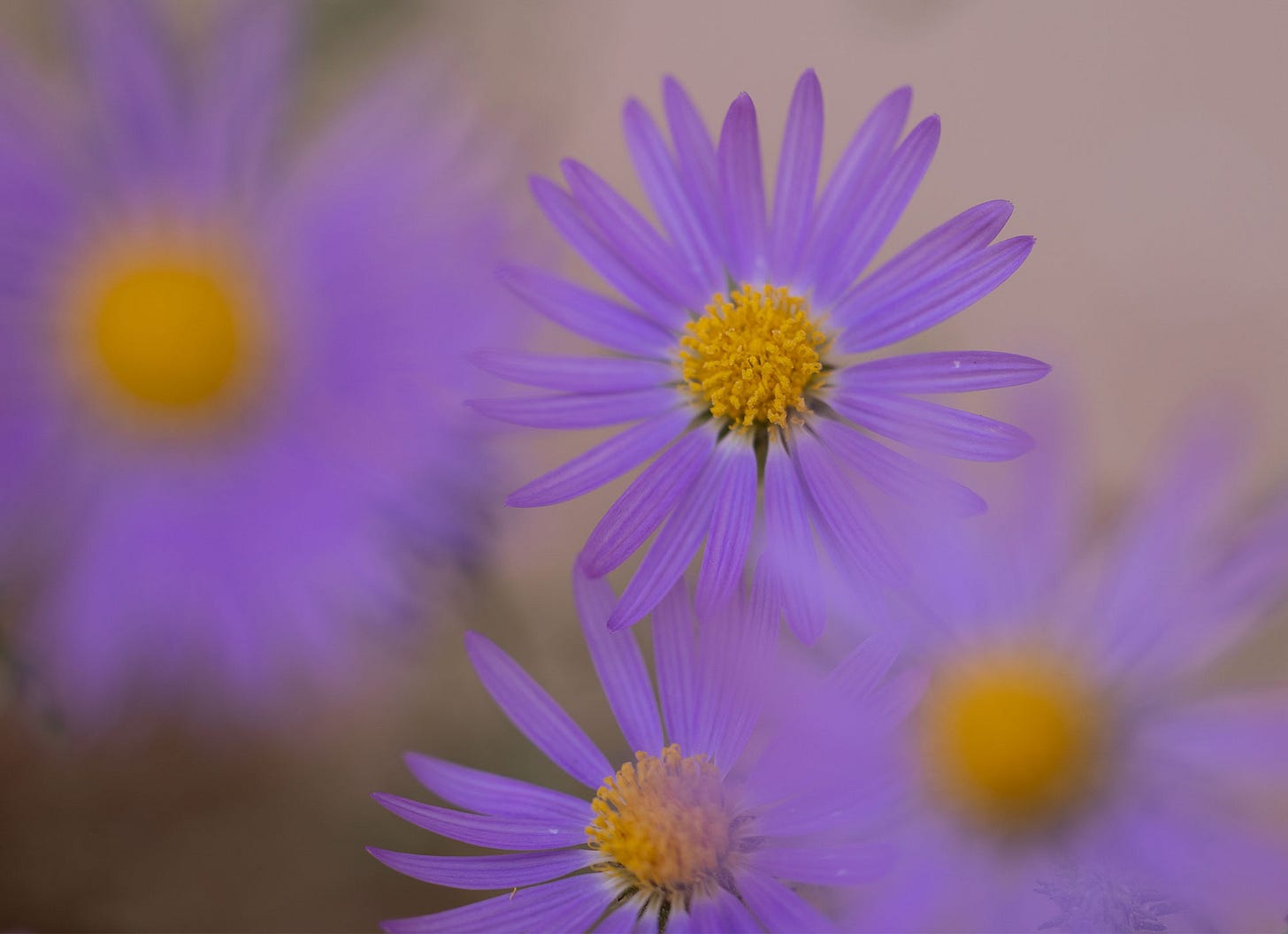Reading Paria Canyon
Paria Canyon isn’t just sandstone and water—it’s a reminder of why we read, and what’s lost when we don’t.
For the best experience—especially with high-resolution images—read this story on my site: Read it on Notes from the Road.
No place in the Southwest glows with the palette of Paria Canyon — amber, terracotta, bone, desert coral — and that’s why I’m here again, walking the soft riverbed with Brian and our guide, Jeffrey.
We walk about 4.5 miles down the canyon, a little farther than we thought, but far enough that we’re low on water for the return hike in the 86-degree heat.
Jeffrey is 68, guiding to stay fit and young. He grew up just a few miles away as the son of a rancher and spent much of his childhood tending to his dad’s cattle in the Paria creekbed. His dad would send him off alone into the Paria for a week at a time, even as young as 11 years old. His job was to fix the fences, haul water to the cows, haul mineral rock to the cows for nutrients, irrigate the alfalfa and keep the water tanks in order. He only realized how beneficial that harsh youth was later in life.
When the afternoon heat starts to weigh on us, Jeffrey explains that he has been a fan of poetry his whole life, and that he’d like to recite some of his favorites as a way to keep everybody focused on the steps. As he cites a handful of Chinese proverbs and some Robert Frost, I realize how beautiful those words are. Yet I never crack open a book of poetry myself.
On our way here, Brian had been telling me the plots of some of the long, world-building science fiction novels he had read — his descriptions of these books make them sound captivating, and yet, like poetry, I steer clear of those weighty sci-fis.
Reflecting on these two preferences, I understand that as a reader, I have some steadfast limitations in what and how I read. I have a subconscious bias toward new books — fresh pages, crisp edges of a newly released hardcover. I almost never touch literature classics, not out of disrespect, but because I have a subconscious need to read the latest to be published. This isn’t a need to be trendy. It’s more like Billy Bob Thornton’s epiplaphobia — a fear of old, moldy antique furniture. And I even have a persistent aversion to books that have already been read by someone I know. Even if it’s a book Jane, my book-loving wife, devoured and recommended, I need my own copy — my own uncracked spine — a clean, personal slate.
I don’t respond well to recommendations either. Something in me recoils at the suggestion of what I should read. It’s not that I don’t trust the judgment of others. I know that in resisting recommendations, I will miss out on brilliant books. But reading, for me, is a solitary map-making process. This isn’t deliberate but subconscious. My brain wants me to discover books on my own terms — to stumble across them in quiet corners of bookstores or through links between ideas I’m already chasing.
Sometimes people will tell me something along the lines of, “You should read more about World War I,” and I understand the impulse behind that suggestion. But I don’t read in straight lines and don’t want to fill in my knowledge gaps through required reading. My understanding of World War I will come to me obtusely, because I passed through the history of naturalists who cataloged species near battlefields or the biographies of architects who rebuilt cities in its aftermath. I have to read within my own limitations, following my own trails — naval epics, pirate histories, memoirs of obscure explorers — and they eventually curl toward the core. In doing so, I may never master a topic in the traditional sense, but I am absorbing the edges, in fragments that build up like sediment over time.
It’s not intentional. It’s that when we read regularly — and by reading, I mean a diet rich in fiction books from reputable publishing houses, nonfiction by experts, and news and culture by established media and credible journalists — the world as seen by readers is more joyous, more full, and more immune to the creep of nonsense, conspiratorial thinking, anti-science and the many other forms of mushy thinking that grow in the minds of those who replace reading with its alternatives.
When I first met my well-read Portland friend Joe, whose career was as a college librarian, he was reading the 1,070-page Cervantes classic, Don Quixote. His wife, like Jane, a book lover, would tear through books. But when we would meet, I would always have to ask Joe how he was enjoying Don Quixote. To this day, 12 years later, I still ask him about Don Quixote. That’s because I always sensed that he had forced himself to read it and would never finish it because of that.

It was through joking with Joe that I realized that understanding our limitations as readers is not a flaw but a strength. When you understand your own reading habits, biases and rituals, you begin to shape a reading life that’s deeply your own. You stop chasing completeness and instead cultivate your curiosity. You learn that it’s OK not to fill every gap, as long as you keep digging. A robust relationship with reading isn’t about covering the canon or obeying the lists — it’s about understanding your reading muses, and then working them into your life.
Over time, I’ve put real effort into shaping how I read — crafting an approach that works for me. I almost always have two books going at once. The more joyful, imaginative or escapist book — whether it’s fiction, travel writing or a survival memoir — I read in physical form or on Kindle. These are the books I return to at night or during those times I can savor them.
I also assign myself a more challenging book — usually nonfiction, science or historical — and I take it in as an audiobook while walking or hiking. The way I tune out life when I’m walking alone helps me absorb ideas I might otherwise find overwhelming or dense. By tying this kind of reading to a time when I’m already focused and unlikely to be distracted, I make sure the more educational content actually sticks. It’s a system that works for me — difficult books become more manageable, and the act of walking becomes more enriching.
Beyond books, I subscribe digitally to The New York Times, The Atlantic and The Economist. These are my anchors in the world of current affairs, long-form journalism and cultural reporting by established journalists. I pair them with my Google News and Discover feed, which tracks my more granular interests — the ones that Google is fantastically good at understanding are for me. Together, these sources form a kind of ecosystem. It’s diverse, it’s high quality, and it’s a reasonable reading load.
This isn’t an accidental arrangement. It’s a reading life I’ve curated with intention — one that acknowledges my habits, and especially my limitations.

Reading is not just about joy and knowledge. Maybe most crucially, it’s the antidote to low-information thinking. It is not lost on me, being out here in rural America, just how much conspiratorial ideas can fester. You pick up on it quick when you listen.
I actually remember how rare conspiratorial thinking was when I first started traveling in the desert Southwest over 25 years ago. I visited the bar at Rachel, Nevada, and met with UFO enthusiasts to listen and talk to them about their theories about aliens visiting Earth. What really shocked me about these self-described ufologists from the Mulder and Scully era was when these middle-aged men began to veer away from UFOs — talk of 9/11 as an inside job, fluoride as mind control, the Illuminati controlling us through Hollywood. I was taken aback that their fringe views about UFOs extended beyond their passion. But that was Rachel, Nevada, not the rest of the world. I could not have imagined that the way they talked had, in 2025, become ubiquitous across so much geography. How did this happen?
The absence of reading creates a kind of vacuum that gets filled with conspiracy, misinformation and simplified stories about how the world works. It’s not unusual to hear people in these isolated Southwest towns speak earnestly about vaccines being government trackers, the 2020 election being stolen, climate change being a hoax, or the United Nations plotting to take away private land. Other ideas swirl in the same spaces — flat Earth, anti-education rants, Great Replacement fears, and the belief that newspapers like The New York Times are not simply biased, but fundamentally evil.
Conspiratorial thinking used to be confined to rural communities in the United States. Multiple studies from the first two decades of the 2000s confirmed that conspiracy theories gained hold mostly in rural areas, due to lower access to formal education, social isolation, and isolation from high-quality reading sources and diverse perspectives.1 2 3
But today it is a global phenomenon, spreading through YouTube algorithms, fractured trust in institutions, and political movements that are keen to weaponize misinformation. From global cities to developing nations, conspiracy theories have somehow come to flourish across borders and class lines, often tailored to local fears but echoing the same patterns of distrust, simplification and scapegoating. What was once fringe is now mainstream in many circles, amplified by echo chambers that reward outrage over reason.
American conspiracy theories, in particular, have proven remarkably exportable. QAnon, originally a U.S.-centric movement tied to Trump-era politics, has spread to Europe, Latin America and Australia, mutating to fit local narratives while keeping its core paranoia intact. Anti-vaccine conspiracies born in American Facebook groups have fueled vaccine hesitancy across Africa and Southeast Asia, undermining public health campaigns. The "stolen election" myth has inspired politicians in countries like Brazil and Hungary to cast doubt on their own democratic processes. Even baseless fears about 5G, once fringe in the U.S., have sparked arson attacks on cell towers in the U.K. and New Zealand. These narratives travel easily, carried by the global reach of American media and tech platforms, giving fringe ideas a worldwide stage.
These kinds of beliefs don’t just arise out of nowhere. They take root where there’s little access to trustworthy media and even less culture of sustained reading. Many rural places used to have local papers. Those are mostly gone now, replaced by Facebook groups, TikTok videos and hours of talk radio. It’s not that people are stupid. It’s that the act of reading — especially reading long-form journalism, history, science or literature — has eroded, and alternatives are cleverly marketed by training their audiences that the world of reading is evil. When people stop reading widely, they become more susceptible to narrow, conspiratorial loops that make them feel informed without actually informing them.
In an age where misinformation is spreading faster than facts, reading widely and deeply is the most subversive act of all. It’s how we inoculate ourselves against the easy allure of certainty and reclaim the complexity of truth.
Reading teaches patience. It teaches that the world is complicated. It offers up contradiction and nuance. And maybe that’s why it’s been subtly vilified by the same forces that push conspiracy: because reading doesn’t hand you enemies — it hands you questions. When you read about a place, especially one far from your own experience, your world gets larger. I like reading about the Arctic when I’m in the desert, or about dense cities while walking through wild country. Hiking Paria Canyon reminds me that movement — whether across landscapes or pages — is essential. And maybe, in a time of information decay, simply choosing to read is one of the most subversive acts we have left.
One of the most effective tools of echo chamber media is their relentless campaign to discredit every other form of journalism. It’s not just that they disagree with the reporting from mainstream outlets — they work overtime to convince their audiences that those sources are actively evil. This isn’t an accident; it’s a marketing strategy. If you can train your viewers or readers to believe that institutions like NPR or The Washington Post are not simply flawed, but corrupt and malicious, then by contrast, your own outlet becomes the only source that can be trusted. It's a form of brand loyalty, built not on merit, but on manufactured distrust.
You can see this tactic at work most clearly in the visceral reactions people have to the mere mention of The New York Times. In some circles, the name alone is enough to provoke a sneer and an immediate dismissal of whatever follows. But what’s ironic — maybe even tragic — is that The New York Times is the opposite of what it’s accused of being. It’s not a monolith of political ideology. It’s a sprawling, sometimes contradictory, deeply researched publication that doesn’t just cover politics — it covers history, science, international affairs, food, fashion, literature, art, health, education, urban design and philosophy. It publishes book reviews, travel essays, obituaries of obscure mathematicians, and deep dives into scientific ethics. It is, in essence, a reflection of a literate, curious society.

Echo chamber media — whether it’s Fox News or one of its even more partisan derivatives — never offer this kind of breadth. They lack any and all culture reporting. They narrow their focus to a handful of emotionally charged topics, day after day, hour after hour, designed to reinforce the same worldview. They don’t cover art unless it offends. They don’t cover science unless it can be weaponized. They don’t cover literature unless it’s to mock it. A well-rounded reading environment, by contrast, is expansive. It invites contradiction, wonder, challenge and curiosity. And that’s the real threat to echo chambers. They don’t just fear different information — they fear a culture of broad intellectual engagement. Because that kind of culture is inherently unstable for them. It teaches people to question, to cross-reference, to compare ideas, and to entertain perspectives outside their tribe. It produces citizens, not followers.
In that way, the real adversary isn’t just The New York Times or NPR — it’s the culture of reading itself. A culture where a person might read about ancient trade routes in Central Asia one day and the chemistry of sourdough the next. A culture where art and data and political reporting share the same page. That kind of richness is incompatible with the diet of grievance and suspicion that echo chamber media relies on. Which is exactly why they try to destroy it.
We are almost back to the trailhead when I remember the tangerine that Brian had placed in my pack. Now completely out of water and parched, this tangerine has transformed into the most delicious, mouth-watering thing I can remember — it’s palm trees and a cold waterfall and an ocean breeze.
On my trip with Brian, cutting across the Southwest, he will often raise a question about the geology or the deep-Earth natural history. And to these questions, I will say, “I don’t know! Let’s read about it!”
Without those questions, what is Paria Canyon? The Paria Canyon — its natural and geological history, its ranching history, its similarities to imagined worlds — can only be truly enjoyed with the power of stories and words. Otherwise, it’s just colored sandstone and shallow water.







